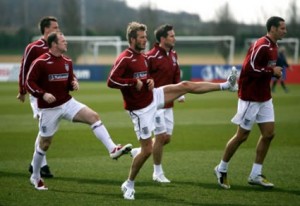GOOOOAAAALLL! We’ve got one question for all of you soccer players…Do you SQUAT? Although we are not expecting any answers back at the moment, we do hope you are saying yes to your computer screen while reading this. It’s not a coincidence if you are reading this and questioning, “Well, why should I squat if I do indeed play soccer?” In all honesty, we could sit here and explain all the great benefits of squats, but that could take a whole other article itself to school everyone on. Instead, we would like to breakdown a study that the great Chris Beardsley and Bret Contreras discovered. The study is about strength training increasing power and speed for elite soccer players. So, if you are a soccer player or coach soccer players we highly recommend you sit back, relax, turn off the soccer on the flat screen for a bit and take some notes.
 If you are a current soccer player or former soccer player, you should know that the sport involves movements that involve speed and power. Ask any Strength and Conditioning coach how important those two elements are for athletic performance. We promise they will tell you it is very damn important for sports performance. If you want to be the best, you have to train like the best!
If you are a current soccer player or former soccer player, you should know that the sport involves movements that involve speed and power. Ask any Strength and Conditioning coach how important those two elements are for athletic performance. We promise they will tell you it is very damn important for sports performance. If you want to be the best, you have to train like the best!
Back to our original question, if you play soccer do you squat? We asked this question because the study we are about to break down by Keiner et al. shows strong correlations that sprint performance and leg strength can improve by doing both back squats and front squats. Man, if only we knew this back in our days when playing futbol, aka soccer. We probably would have been bending it like Beckham 😉
SO WHAT DID THE RESEARCHERS DO?
The researchers wanted to track the development of 30m sprint performance in youth soccer players over a 2-year strength training intervention. So, they recruited 134 elite soccer players, not world cup stars ladies and gents. The players were
subdivided into three age-groups (A, B and C cohorts) and the average ages of each group were 17, 15 and 13, respectively. To be very clear here, the participants in each cohort were divided into two groups. One group (Strength training group [STG]) was subjected to regular soccer training in addition to strength training twice a week for 2 years. The other group (Control group [CG]) completed only the regular soccer training.
The strength training group performed their workouts on non-consecutive days and the exercises varied between the parallel front and back squats during the week and also performed bench presses, deadlifts, neck presses, and exercises for the trunk muscles as well as the standing row.
Squat training for the strength-training group was periodized such that following initial technique training, the subjects started with a hypertrophy training block, which comprised 5 sets of 10 repetitions with 3-minutes rest between each set.
The next training block comprised a strength period of 5 sets of 6 repetitions with 3-minutes rest between each set followed by an additional training block of 5 sets of 4 repetitions with 5-minutes rest between each set. The researchers measured 30m sprint times, including splits every 5m, and maximum 1RM front and back squat strength after two years of training.
SO WHAT HAPPENED AFTER ALL OF THIS?
For Maximum Strength, the researchers reported that the strength-training subgroups of all three age-groups displayed greater improvements in the front and back squat 1RMs than the control sub-groups.
For 30m Sprinting Performance, the researchers found that in the A and C groups, the strength-training sub-group displayed significantly better reductions in sprint time than the control sub-group at each 5m split time between 5m and 30m. They found that in the B group, there was a significant difference between the strength-training and control sub-groups at the 5m, 20m and 25m splits.
Correlations: the researchers performed a correlation analysis and found that there was a significantly positive but moderate relationship between strength gains in 1RM expressed relative to body weight and improvement in sprint performance in all age groups. The correlations were highest for the first 15m of sprinting, indicating the greater importance of squat strength for accelerating rather than maximal speed sprinting.
 WHAT DID THE RESEARCHERS CONCLUDE?
WHAT DID THE RESEARCHERS CONCLUDE?
The researchers concluded that a strength training program involving front and back squats led to a positive improvement in the sprinting performances of young soccer players. Pretty cool. Right?
WRAPPING THIS ALL UP
As you can see the research doesn’t lie. Of course there were limitations, but all studies have limitations. And, at the end of the day if those do not agree with these findings, that’s ok too because science is always open to debate. We can definitely tell you from anecdotal experience that squats and front squats will 99.9% of the time increase speed, power, hypertrophy, strength, and overall athletic performance. In other words, we highly agree and approve of this study by Keiner et al. So, just too briefly recap, if you are a soccer player, coach, or just an overall jock, we highly recommend you implement some sort of squat variations into your training regimen to maximize your full potential. Don’t get us wrong here ladies and gents, we are not asking you to go load up a squat bar and max out for 500 lbs. We are simply saying whether its conventional back squats or front squats that you chose to do, do them with proper precautions, make sure you squat deep, and don’t be afraid to progressively overload. And hey, if you squat more often, maybe you will score more GOOOOOAAAAALLLLLSSSS than the famous “Pele” did.
About The Authors:
Chris and Eric Martinez, CISSN, CPT, BA, also known as the “Dynamic Duo” operate a world class personal training and online training business “Dynamic Duo Training,” They’re also fitness and nutrition writers, fitness models, and coaches that love helping people reach their goals. Their philosophy is “No excuses, only solutions.”
Visit them at:
References:
1). Influence of a 2-year strength training programme on power performance in elite youth soccer players, by Sander Keiner, Wirth and Schmidtbleicher, in European Journal of Sport Science, 2012.
2.) Chris Beardsley and Bret Contreras, 2012.



